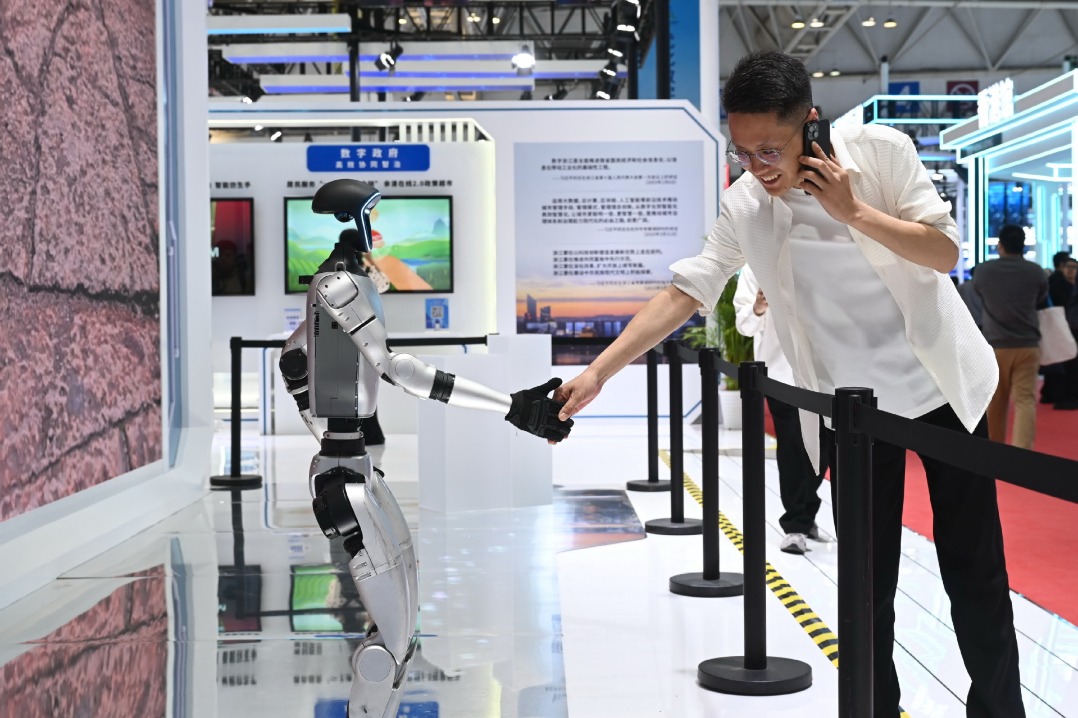Drones, electric lift devices transform grid maintenance


"Drone inspection complete, surrounding environment clear, ready for takeoff," said Sun Kai, a power line maintenance technician conducting repair work in the Gobi Desert in Yongning county, Yinchuan of the Ningxia Hui autonomous region.
Like taking an elevator up to reach an office, power line workers use flying equipment to rise from the ground to reach 25-meter-high lines in about three minutes. And within 40 minutes, they complete the live-wire repair job.
"This is the fastest I've completed a task in my years of maintenance work," said Sun.
"The 'flying man' equipment allows us to go directly to the work point without climbing scorching towers or winding through ladders, preserving our energy for handling the defects. Additionally, the dual protection of transmission and backup ropes ensures safety throughout the process."
The "flying man" equipment is a portable electric lift device developed for high-altitude work and rescue, using a motor to assist personnel in ascending, descending and hovering on suspended insulated ropes.
Drones can carry and deploy insulated traction ropes, using small ropes to pull larger ones over the wires to the ground, establishing ascent and descent channels and safety backup routes for high-altitude workers.
The integration of drones and electric lift devices in power line maintenance is set to become a mainstream approach for live-line operations, said the workers of State Grid's Yinchuan Power Supply Co, who use the device.
"Compared to traditional tower climbing and insulated ladders, it reduces the number of high-altitude workers from two or three to one, saves about two hours per task, minimizes safety risks, reduces labor intensity, and significantly enhances operational efficiency and safety," said a company representative.
Lin Boqiang, head of the China Institute for Studies in Energy Policy at Xiamen University, said China has promoted the intelligent transition of its power grid in an orderly manner over the past few years.
"As a wide range of high-end technologies and devices like the 'flying man' equipment continue to emerge across the country, the transition process is expected to be further advanced and accelerated," said Lin.
Meanwhile, about 34 kilometers away, a drone scans the radio frequency identification tags on electrical equipment, collects the required information and promptly transmits it to the power supplier in Xixia district of Yinchuan.
An RFID tag is an electronic tag that exchanges data with an RFID reader by using radio waves. It could help identify an item, track its location and record its movement.
State Grid's Xixia Power Supply Co started to utilize such drones and RFID tags to inspect the power grid at the end of 2022, which has not only improved its work efficiency, but also significantly lowered labor costs.
The company said currently all the utility poles, transmission towers, transformers and main ring units in the district are equipped with RFID tags, which has made the management and deployment targeting them more efficient and accurate.
Besides, the company said it had equipped the drones with high-resolution cameras and RFID readers and has constructed an online system to aggregate all the data concerning local electrical equipment.
During the inspection process, the drones could first understand the equipment's operation status by reading the RFID tag and then compare it with the historical data in the system, so as to effectively identify the hidden hazards, said the company.
Zhou Mi, a researcher at the Beijing-based Chinese Academy of International Trade and Economic Cooperation, said the development environment for China's power grid has changed significantly over recent years — renewable energies are gradually replacing traditional ones, and the rapid development of electric vehicles has generated new demand.
Zhou said the proper utilization of drones, artificial intelligence and other high-end technologies could help match supply and demand in the sector, and allows the power grid to achieve transformation more smoothly. Such moves will also inject fresh impetus into the country's economic growth and environmental protection.
Jiyuan, a county-level city in Central China's Henan province, has also actively utilized drones to inspect and improve the local power grid, as part of its efforts to ensure stable power supplies.
When a power grid fault occurs, drones will receive instructions from a flaw detector and promptly fly to the problem area.
Making use of advanced AI technologies, the drones are able to accurately identify the problem, capture images and assign tasks to the maintenance personnel accordingly.
In addition, the drones could help collect the images and coordinates of local utility poles, thereby further enriching databases and increasing the accuracy of the grid map.
Zhou Bocheng, a staff member of State Grid's Jiyuan Power Supply Co, said 88 percent of the city is covered by mountains and hills, and the transmission lines span forests, valleys and rivers.
Zhou said such a complex geographical environment used to seriously hinder the inspection and maintenance of the power grid, because the workers had to travel to the problem areas.
"Thanks to the drones, now all the transmission lines can be inspected via computers, which has significantly improved our work efficiency and made the work process more transparent," said Zhou.
"Nowadays, in just 30 minutes, a drone could complete a task that used to take two people three hours."
According to the company, continuous efforts will be made to expand the application scenarios of drones and thereby better meet local electricity needs.
Their moves came after the National Energy Administration released guiding opinions on the high-quality development of the power grid in February, which stressed further efforts to empower the digital and intelligent transition of the power grid.
The guiding opinions said cutting-edge technologies such as network communication, big data and automation will be better leveraged, and scientific and technological innovation in the sector will be further promoted. Efforts will also be made to step up the upgrading and replacement of old and energy-intensive equipment.
With the transition completed, the country is expected to better integrate renewable energy sources into the power grid, and ensure its stable and energy-efficient operation.




































